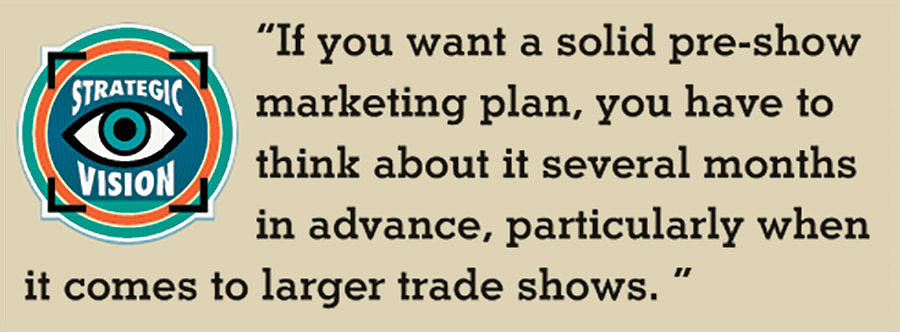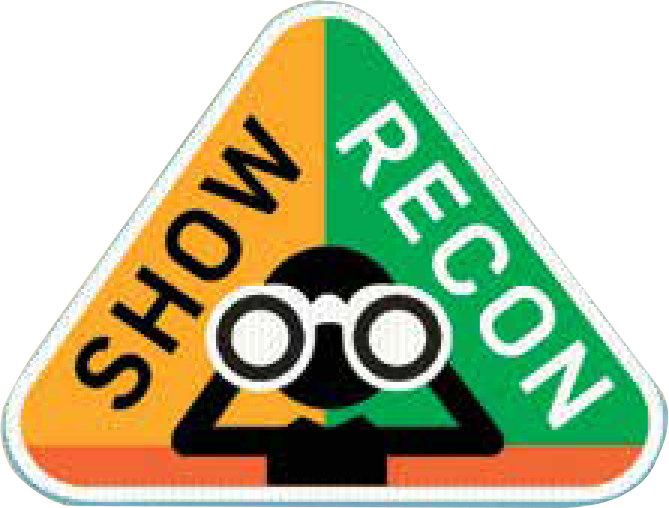|
REGISTRATION REQUIRED
interview

ILLUSTRATION: NIGEL BUCHANAN
Trade Show Survival Guide
Timothy Patterson, author of "Tradeshow Success: 14 Proven Steps to Take Your Tradeshow Marketing to the Next Level," explains
what exhibitors are doing right – and what they're missing. By Claire Walling
While today's marketing students are significantly more likely to be exposed to the idea of trade shows and corporate events in college, the vast majority of exhibit managers still enter the industry with little to no knowledge of what the job actually entails. And the baptism by fire they experience after being handed a company's trade show reins is often less of a slow burn and more of a five-alarm inferno as they scramble to learn as much as they can as quickly as possible. Timothy Patterson, founder of Oregon Blue Rock LLC, has encountered the aforementioned situation time and time again, and that inspired him to write "Tradeshow Success: 14 Proven Steps to Take Your Tradeshow Marketing to the Next Level." The book creates an actionable framework that marketers can use – either in its entirety or a la carte – to plan trade show programs, from sketching the first exhibit design to following up on the last lead from the show. Here, Patterson talks about budgets, booth building, and more, offering nuggets of information that both rookies and veterans can readily digest. EXHIBITOR Magazine: Your book touts 14 steps that will help marketers take their trade show programs to the next level. But is there one step that's an exhibit-marketing silver bullet?Timothy Patterson: I think that all 14 steps are important, but the most mission-critical step is training frontline staff. A lot of marketers overlook the fact that they're dispatching booth staffers to be the face of their companies and chat with attendees for eight hours a day, three or more days in a row. There's a lot of interaction that occurs on the trade show floor, and if staffers are trained properly, that can exponentially increase your company's lead-gathering potential. Specifically, training your staff on lead collection will benefit your sales force. If staffers know how to properly collect and qualify leads, salespeople will in turn know whom to call, when to call, and what the call is about when those leads are passed on to them. EM: On that note, what's the most serious gaffe that you've ever observed a booth staffer make on the show floor? TP: I wouldn't say that there's a specific instance that stands out, but so much of the interaction that occurs in an exhibit is really not taken as seriously as it should be. I frequently see things such as staffers eating, talking on their cellphones, and standing in closed-off body positions with their arms crossed. They aren't welcoming, they're not greeting people, and they're not smiling. There are a lot of little things in body language and presentation that can really turn people off. If attendees walk past the booth and see staffers in the back eating a sandwich or with their heads buried in their phones, that sends a nonverbal message to potential visitors that "You're not important enough for me to greet you." This type of occurrence is why staff training is critical. All those little things will turn attendees off, and they'll just keep walking. EM: Which step are exhibitors most likely to overlook?TP: Many companies fail to connect with the gaggle of industry-specific media that attend virtually every trade show. Concentrated public-relations efforts that build long-term relationships with writers and media outlets can be a boon for your exhibiting program. Press coverage gets your company noticed, which can help drive more traffic to your booth. But if you don't have those existing relationships, your options are to build them from scratch – which can take a lot of time and effort – or to work with a public-relations agency that already has strong connections. A lot of companies fail to even think about a comprehensive media strategy for their exhibiting efforts because they don't know how to go about it. 
TP: If a critical mass of your competitors attends a show, it's a telling sign your firm should at least consider exhibiting there as well. However, if most of your competitors aren't at a given show, you have to wonder if that audience is suited for you – or if the lack of competitors might make for lots of low-hanging fruit. If you're unsure about exhibiting, I always recommend attending the show first. Walk the aisles, talk to other exhibitors, and see what kind of audience is there before you sign on the dotted line and purchase booth space. A show website will give you a lot of that information, but until you get there and talk to people, you're only getting one side of the story. EM: When it comes to trade shows, money is on everyone's minds. Is there a magic formula for determining how much cash it will take to have a productive exhibit-marketing program?TP: There's no simple answer to this question. Every exhibitor has different goals, and they have different basements and ceilings for their budgets. If you've exhibited in the past, you likely have some idea of how much money it's going to take. But if you've never exhibited before, you're going to have to do some investigating and uncover the hidden costs. That means asking questions about the price of show-floor concrete, average travel and lodging costs, and drayage rates, among other things. On the flip side, if your company has attended the same show for a number of years, it's important to track each line item so you can see if your budget is being allocated appropriately. That will give you a clearer picture of where you can save money the next time. Are you spending too much on drayage? Are labor costs to set up and dismantle your booth eating up your budget? It's a matter of asking those questions and making absolutely sure you understand where the money is going. EM: Your book includes a thorough discussion on the often harrowing process of building a new booth. That raises an important question: Is a custom exhibit worth the expense?TP: If you're buying a custom exhibit, you're buying something that no one else has. If you work with a designer who understands your brand, you're going to end up with a great exhibit that is unique to your company. One show I like to attend every year is Natural Products Expo West. With almost 3,000 exhibitors, there are some very unique booths made out of recycled wood and bicycle frame parts, for instance. Those elements paint a really specific image of each company for attendees walking by, and that's why I think it's important to take advantage of a custom booth. EM: Let's talk about another step: pre-show marketing. What do exhibitors do wrong when it comes to this crucial piece in the trade show puzzle? TP: The biggest mistake is that they often tend to throw darts at the board a couple weeks before the show. If you want a solid pre-show marketing plan, you have to think about it several months in advance, particularly when it comes to larger trade shows, where thousands of exhibitors are all fighting for attendees' attention. Unfortunately, a lot of companies – especially smaller ones – let this critical step fall by the wayside due to a lack of time and resources. There's a lot that marketers can do, from public relations to direct mailers, but they don't look at pre-show marketing with a holistic approach. Some marketers send out a single email blast one week before the show, or they decide two weeks beforehand that they're going to start tweeting their booth number to followers. All of that is important, but if you really want to drive traffic to your booth, you need to be more thoughtful with your pre-show marketing. Think about the messages you want to send, who you want to receive those messages, and how you want that audience to react when it interacts with them. EM: Any last words of advice for exhibitors – both for rookies and those who have been in the industry since the time of dial-up Internet?TP: Exhibitors need to spend more time planning. Many marketers look at the calendar and say, "Gosh, I have to go to a trade show in two months, and I don't have anything in place." As a result, their strategy is often more of a "shoot from the hip" approach. Instead, they need to be saying, "Exhibiting accounts for a third of our marketing budget, so we need to look at our approach from all angles." E
|
|
||||||||||||||||||||||||||
|
||||||||||||||||||||||||||||
|
|
||||||||||||||||||||||||||||
|
TOPICS Measurement & Budgeting Planning & Execution Marketing & Promotion Events & Venues Personal & Career Exhibits & Experiences International Exhibiting Resources for Rookies Research & Resources |
MAGAZINE Subscribe Today! Renew Subscription Update Address Digital Downloads Newsletters Advertise |
FIND IT Exhibit Producers Products & Services All Companies Get Listed |
EXHIBITORLIVE Sessions Exhibit Hall Exhibit at the Show Registration |
ETRAK Sessions Certification F.A.Q. Registration |
EDUCATION WEEK Overview Sessions Hotel Registration |
CERTIFICATION The Program Steps to Certification Faculty and Staff Enroll in CTSM Submit Quiz Answers My CTSM |
AWARDS Exhibit Design Awards Portable/Modular Awards Corporate Event Awards Centers of Excellence |
NEWS Associations/Press Awards Company News International New Products People Shows & Events Venues & Destinations EXHIBITOR News |
||||||||||||||||||||
|
||||||||||||||||||||||||||||







